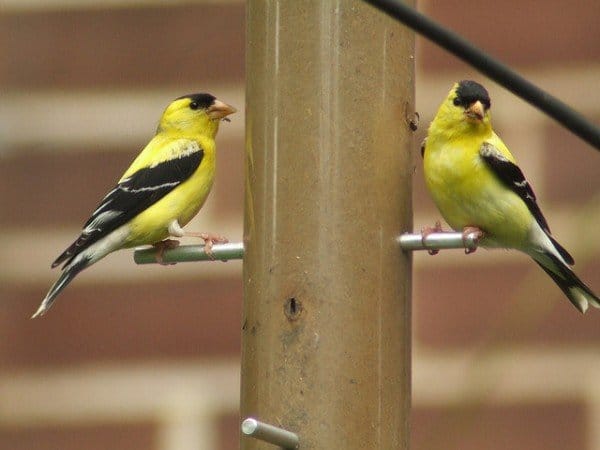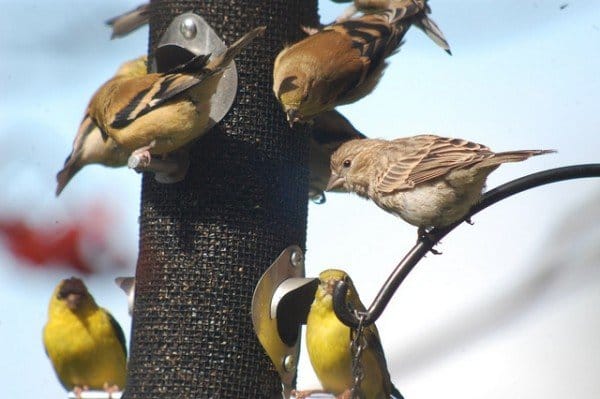Have you had trouble keeping finches at your feeder? If so, you’re not alone, it’s a common bird feeding question.
American Goldfinches are one of the prettiest reasons to keep your feeders full in the summer. It seems that goldfinches are so pretty they know they can afford to be a bit more finicky than other birds. But by following a few of rules of thumb, you can keep finches around and keep them satisfied:
1. Purchase Often & Purchase In Small Quantities. The food for finches can go by a variety of names: Thistle or Niger or Nyjer (and that’s just one seed that doesn’t include all the finch specific mixes on the market). Nyjer is not grown in the United States and is imported from a variety of places including Burma, Singapore, Ethiopia and Myanmar. Unlike sunflower seed, Nyjer loses its appeal as it ages. You can purchase a huge bag of black-oil sunflower seed and the birds will still eat it over a year later (provided it isn’t chock full of moth larvae and has been stored in a cool, dry place). Once Nyjer is about six months old, finches lose interest in it, so when you purchase the seed, purchase it in smaller quantities and purchase more often.
If you’re not sure if your finch food is old, ask yourself how long ago you bought it. If it’s more than six months, purchase some fresh seed. If you see a finch food clearance sale, beware. Chances are that store is trying to unload product that’s about to go bad.
2. Keep Finch Food Fresh In The Feeder. This is a great rule of thumb for bird feeding period. Many finch feeders are a screen type, like the one above and the finches can cling to the side and pull out the small Nyjer seeds. But this leaves it suseptible to the elements. When it rains, the seed gets wet. With some seeds, birds will still eat it, not usually the case with Nyjer. Once the seed has gotten wet, the finches usually will not eat it. Check your feeder after a good rain, make sure the seed isn’t clumping up with mold. If it is, clean out the feeder and put in fresh seed.
If you aren’t certain if your food is bad in the feeder, watch the finches. If the food is fresh and tasty to them, a finch will perch for awhile and chow down. If a finch lands on a perch and takes a peck, then moves to a different perch to take a peck and then to a third and only takes a peck, that is a sign that the food is either too old or possibly moldy.
3. Finches Don’t Like Change. Most birds are creatures of habit and that goes double for goldfinches. Besides Nyjer, you can get finch mixes. If goldfinches are used to straight Nyjer in your feeders and you switch to a finch mix with a variety of seeds, they sometimes will avoid the feeder until you go back to offering the plain Nyjer (the reverse can also be true). Even a new style of feeder can make finches avoid the feeder. Keep it simple and worry about offering the latest and greatest if your finches are already used to one kind of seed.
So, if finches are avoiding your feeders, look over those rules and see if any of them apply to your feeding situation.













It is obviously a season for finches in our area. I see them all the time, and especially in my garden as my neighbour has the bird feeder. They are such a nice and vibrant birds. Thanks for sharing, Anna 🙂
Great info about the finch food. I have been seeing less finches now that it is summer. I assumed it was because of all the flowers and seeds.
Our Double-barred finches in the garden are happy with “Budgie food” from the supermarket-“Wild bird food” is too big! We have a pole with two saucers spaced so that the doves are too big to get in the gap and the finches get the food. It keeps rain off in the Wet season as well.
I have lots of Goldfinches at my feeders, and they still show up even when I go from Nyjer to a mixed seed. Sometimes i think they enjoy the change, as they seem to gobble up the mixed stuff quicker!
Dear Sharon – Good advice! Way over here on the west side of the continent, on Gabriola Island in British Columbia (an island with the same area as Manhattan but 4000 residents) the American goldfinches are brightening up the yard as they wait for the thistle to bloom. Such a treat.
Although the information provided may be true in some instances, I’ve seen goldfinches MANY times do what the information says they won’t do such as eating old seed and seed that’s been rained on and molded.
Interesting read, thanks! I’ve got lots of different finches here in my yard in Oklahoma. I use black oil sunflower seed and they have always eaten it. They come throughout the Summer. I have lots of feeders so purchase the seed regularly.
Hey Sharon, great post on the Finches and Nyjer seed. I have two 36 inch Nyjer tube feeders that I have to fill every couple of days (which isn’t cheap at around $30 for 20 pounds).
The little buggers have slacked off lately because of all the weeds going to seed around the property and the sunflowers getting big in the garden (my Lesser Goldfinches love eating the sunflower leaves).
I wanted to let you and the readers know about an American company that does sell Nyjer seed grown here in the U.S. and it’s not sterilized like the foreign seed. You can actually sow the seed and grow your own Nyjer! It ain’t cheap though. It’s almost twice the price of the foreign grown stuff. You can find the American Nyjer seed website here.
I wrote a post about it a couple of years ago and wanted to try growing some of my own Nyjer but the owner was out of seed stock and the next year he sold the business. I kind of forgot about the whole thing but now I think I might do it next Spring.
I have also found that there is a huge difference between the different brands of all the “regular” imported Nyjer seed. Some brands have much more dirt in the seed than others. I have even found small pebbles in some brands of Nyjer seed.
Hello
I use finch feast by suncrest farms I get 20 pounds $38. I wish I could get the nyjer seed for that price I was able to get 2.2 pound bag for $16 this is not including high taxes. I live in Vancouver British Columbia in the downtown area and bird feed is expensive.
Live in an apartment complex and someone is tampering with my feeders. I have had them emptied parts taken off them so they no longer hold seed. Suet holder went same day it was put up. These are not cheap here. A few days ago a guy went under my feeder and put down 10-15 pieces of corn. He had it in a small bottle that you buy spice in. I think the corn is poisoned, as there was ample feed. I have the corn and want to get it tested any suggestions. I cannot afford to test myself. I called the SPCA and they could not help and was told I had to test it myself and call Environment Canada. I caught the guy in the act opened the window and he took off. I think he is the one that is emptying the bird feeders. I went through 20 pounds in 4 weeks 1 smallish feeder. I have moved the feeder to the side of the building next to my window to keep it safe but there is no shelter for the birds. Before the feeder was under my fir tree. I also had to make a top to protect feeder from the rain and it is getting soaked every day, as it is rainy here right now. I have many types of birds that visit some I have no idea what they are. I also put bird peanuts in the bush area these go fast. Also keeps the squirrels out of my feeder. I have 2 squirrels that open my feeder and sort through the seeds. This particular feeder has other seeds in it. I think small pieces of corn that they like. Not sure what they want in there but if I do put out some peanuts they open it up and sort through it. If anyone has any suggestions about protecting the feeders, how to test the corn for poison please let me know. No one puts a few grains of seed on top of ample birdseed. The pigeons went below the feeder when it was under the fir tree they do not feed from side where the feeder is now.
I am going to buy a Voyager SMARTBOT Network Security Camera to set up to catch the guy. Just doing research on the product. If anyone has a system I would love to hear from you. One camera is all I need I intend to set it up looking out the window where he put the seed the last time. If I catch him I will call the police once I have the corn tested.